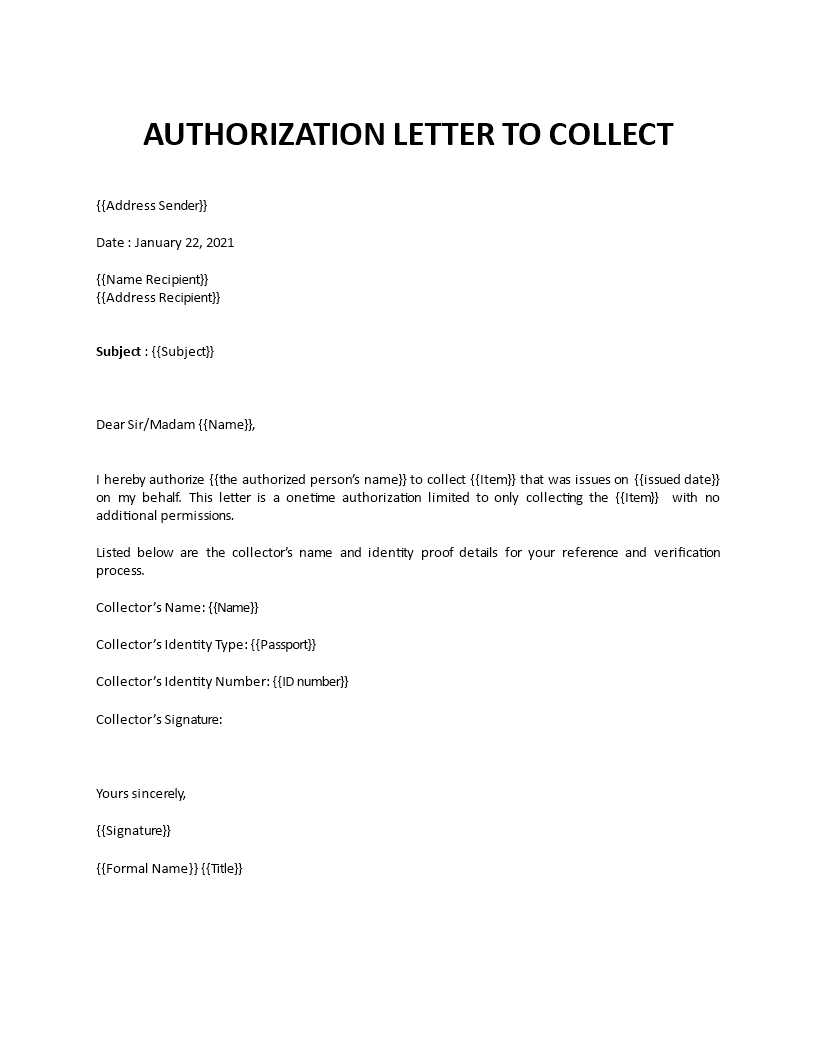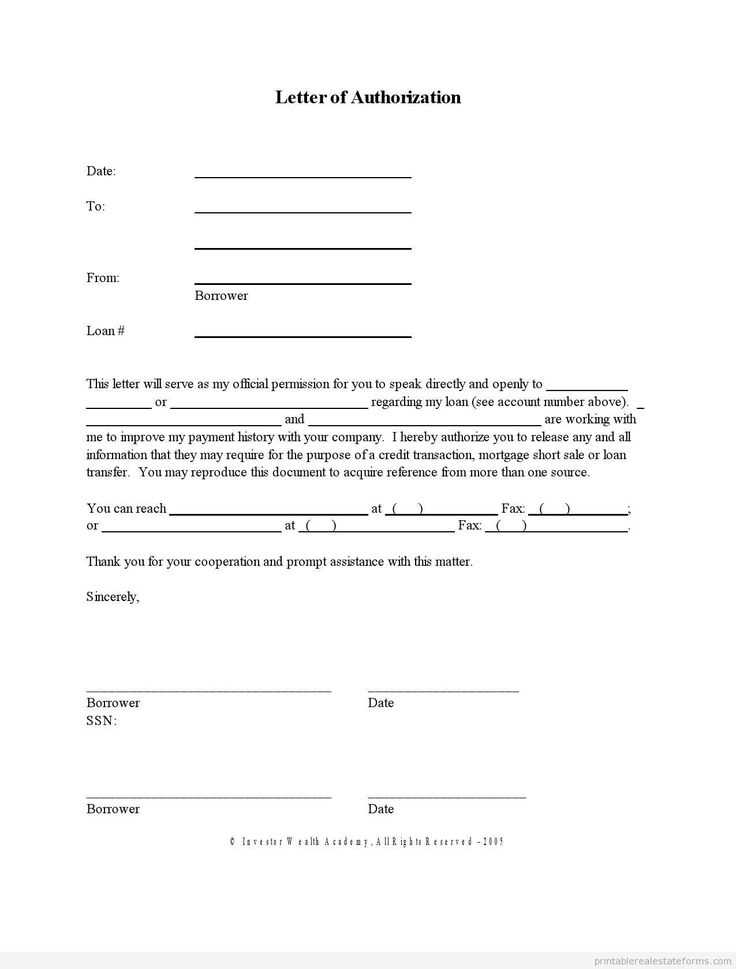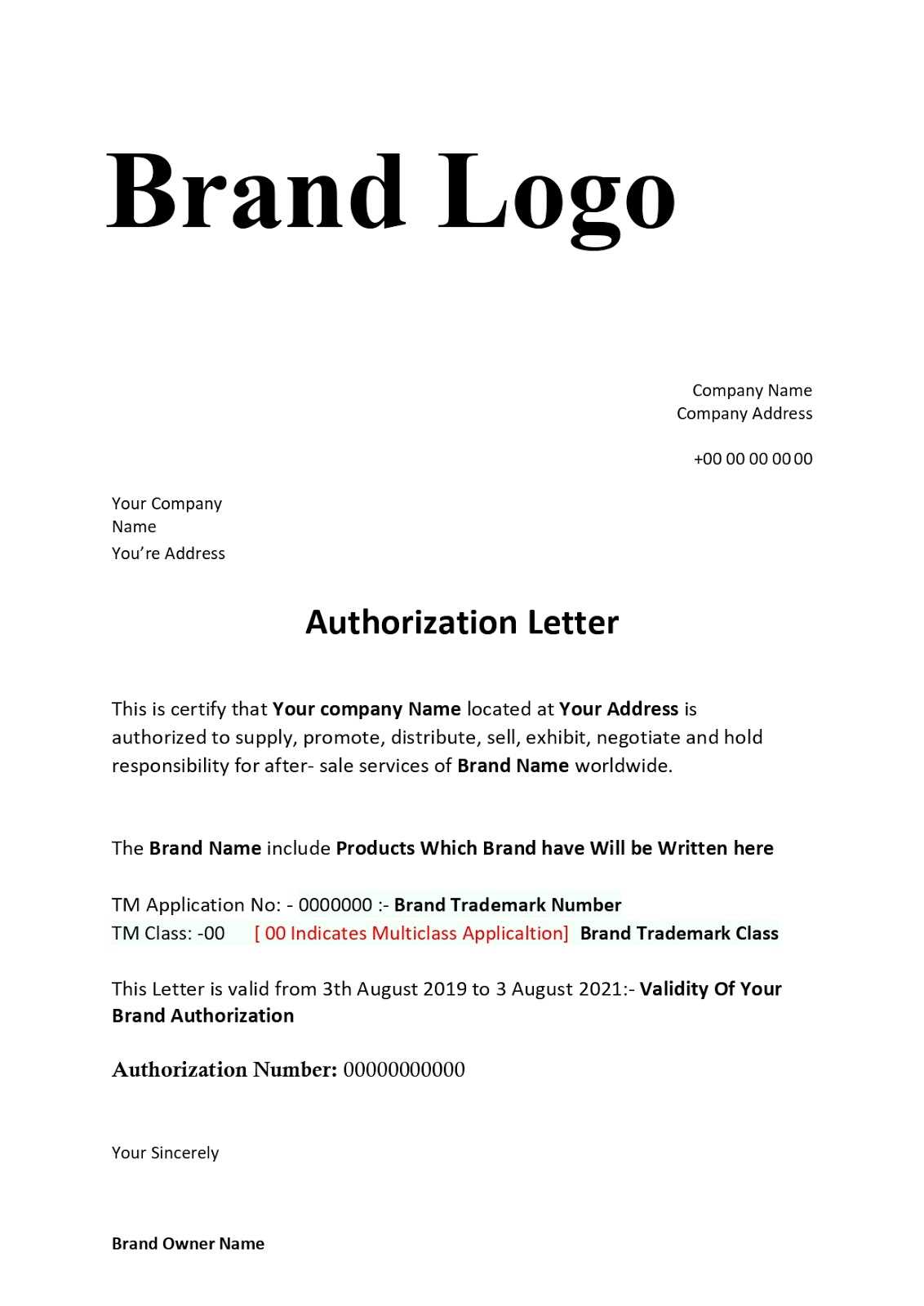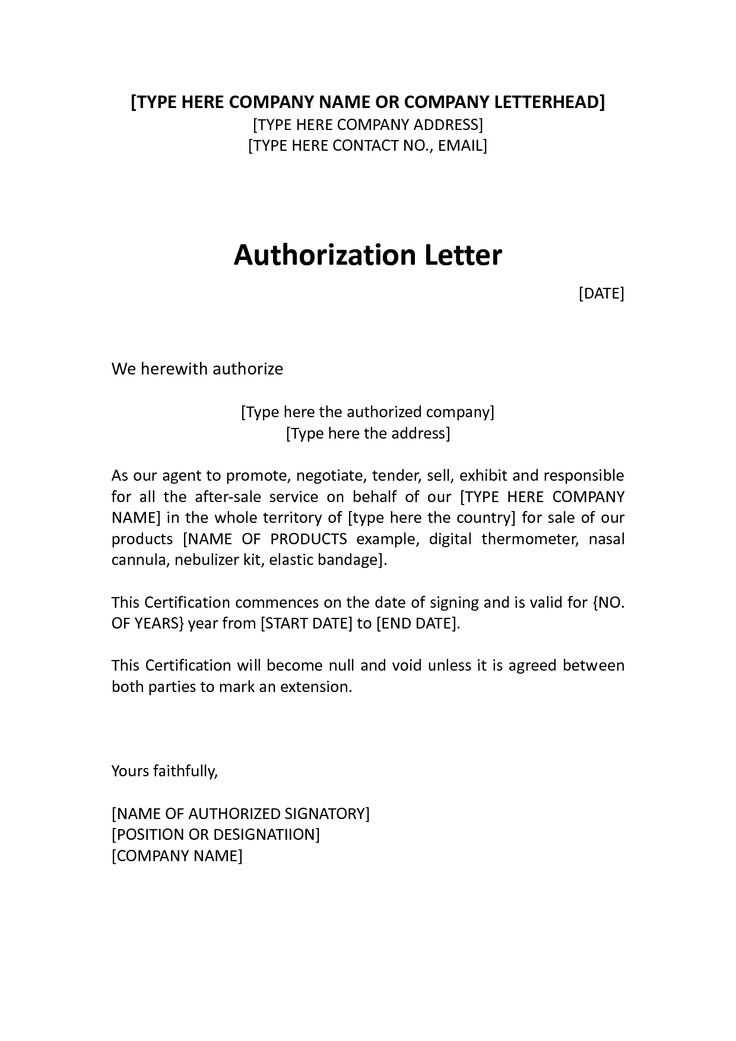Letter of authorization template

Use this letter of authorization template to grant permission to another person or organization to act on your behalf. A well-written authorization letter ensures clarity in your intent and avoids confusion during the process.
The template should include specific details, such as the name of the person you are authorizing, the scope of authority being granted, and the duration for which the authorization is valid. This will prevent misunderstandings and provide a clear framework for the actions being taken.
Make sure to tailor the template to fit your unique needs. Include information relevant to the task at hand, whether it’s for managing business affairs, receiving documents, or any other responsibility. The letter should reflect the nature of the authority being delegated.
Always sign and date the letter to confirm its validity. Depending on the situation, you might also need to have the document notarized or witnessed for additional legal strength.
Here’s the revised version with minimal repetition: htmlEdit
Begin by including a clear title at the top of the letter. Use “Letter of Authorization” or a similar straightforward phrase to ensure the recipient understands the purpose immediately.
- Header Information: Include your name or the organization’s name, address, phone number, and email address at the top. These details establish authenticity and facilitate contact.
- Date: Include the date the letter is being written. This helps to clarify the timeframe of the authorization.
- Recipient’s Details: Include the recipient’s name, organization, and contact information. This shows to whom the authorization is directed.
In the body, clearly state the specific tasks or actions that the recipient is authorized to carry out. Use direct language and avoid ambiguity to prevent misinterpretations.
- Authorized Task Description: Specify exactly what actions are permitted. Avoid generalizations like “manage” and focus on specifics, such as “sign documents related to project X.”
- Duration: Mention the time period during which the authorization is valid. This ensures clarity regarding the start and end dates of the authorization.
- Conditions: If there are any restrictions or limitations on the authorization, outline them here. This is critical to prevent misuse of the letter.
Conclude the letter with a clear and direct statement of your consent. This final section should reaffirm your approval for the recipient’s actions.
- Signature: Sign the letter at the bottom to authenticate the document.
- Witness (if required): Some situations may require an additional witness signature to validate the letter. Make sure to include this if needed.
By following these steps, you ensure the letter serves its intended purpose without excess verbiage or confusion.
Understanding the Purpose of an Authorization Letter

An authorization letter serves as a formal document that grants one person permission to act on behalf of another. This could involve handling financial matters, picking up documents, or completing other official tasks. By providing written consent, the person issuing the letter confirms trust in the authorized individual’s actions. It is a straightforward method to ensure that the recipient has legal backing to perform specific duties.
When drafting an authorization letter, it’s crucial to include specific details such as the tasks to be performed, the duration of the authorization, and any limitations. This ensures both parties understand their roles and responsibilities clearly.
Key Elements of an Authorization Letter
The following points should be clearly stated in an authorization letter:
| Element | Description |
|---|---|
| Grantor | The person giving permission. |
| Grantee | The individual receiving permission to act on the grantor’s behalf. |
| Specific Task | A clear description of what the grantee is authorized to do. |
| Time Frame | The period during which the authorization is valid. |
| Signature | The grantor’s signature to validate the authorization. |
When to Use an Authorization Letter
Authorization letters are often used in scenarios where personal presence isn’t feasible. For example, when someone cannot personally pick up a package or attend a meeting, an authorization letter allows another individual to handle such matters in their place. This document ensures that both the grantor’s and grantee’s rights are protected and that the transaction goes smoothly.
Key Elements to Include in an Authorization Letter
Start with the full name of the person granting the authorization and the person being authorized. This clearly identifies both parties involved in the process.
1. Clear Identification of Parties

- Include the full legal name of the person giving permission.
- State the name of the person who will act on behalf of the other party.
2. Specific Authorization Details
Be specific about what the authorized individual can do. This prevents any misunderstanding about the scope of authority being granted.
- Describe the task or tasks the authorized person is permitted to perform.
- State any limitations or boundaries related to the action.
3. Date and Duration of Authorization

Indicate the start date and any applicable end date for the authorization. This defines the period within which the authorized individual can act.
4. Signature and Contact Information
End with a signature from the person granting authorization and their contact details. This confirms the authenticity of the letter and provides a way for the authorized person to verify or clarify any details.
- Signature of the authorizing party.
- Contact phone number or email address for further verification if needed.
How to Format an Authorization Letter for Legal Use
To create a legal authorization letter, clearly define the purpose of the authorization and provide all necessary details. The letter should be concise, direct, and include the following components:
1. Heading and Date: Begin with your full name and address at the top of the letter, followed by the date. This establishes the official nature of the document.
2. Recipient’s Information: Include the name, title, and contact details of the person or entity receiving the authorization. This ensures the letter reaches the right party.
3. Statement of Authorization: Clearly state that you are authorizing the recipient to act on your behalf. Use precise language, such as “I authorize [recipient’s name] to…” and specify the exact scope of their authority.
4. Detailed Purpose: Explain the specific actions the recipient is authorized to perform. This ensures there is no ambiguity regarding the tasks they can undertake.
5. Duration: Indicate the start and end dates of the authorization, or specify whether it is valid until further notice. This establishes the time frame of the agreement.
6. Signatures: Include your signature at the bottom of the letter. For legal validity, also provide a space for a witness or notary public, if necessary.
7. Contact Information: Finally, include your phone number or email address so the recipient can contact you if further clarification is needed.
Ensure the letter is clear, direct, and free of unnecessary information to maintain its legal effectiveness. Keep a copy for your records.
Common Mistakes to Avoid When Writing Authorization Letters
Neglecting Specific Details: Always include clear and precise information about the scope of the authorization. Vague language can lead to confusion about what the person is authorized to do. Be specific about dates, actions, and limits of authority.
Omitting Identification Information: Ensure you provide full identification details of both parties. Include names, addresses, and other relevant identifiers. This avoids potential misunderstandings and validates the legitimacy of the letter.
Missing Signatures: An authorization letter is incomplete without signatures. Both the authorizing person and the authorized person must sign the letter to confirm the intent and consent. Without this, the letter may not be considered valid.
Not Notarizing the Letter (When Required): If the authorization pertains to sensitive or legal matters, it’s often necessary to have the letter notarized. Failing to do this could invalidate the authorization in certain jurisdictions or for specific tasks.
Ignoring Legal Language or Requirements: Different tasks may require specific legal language. If you’re unsure, consult legal templates or professionals. Using inappropriate terms can cause the letter to be rejected or misunderstood.
Incorrect Format: Follow a clear and professional structure. Use proper salutation, body, and closing sections. Avoid informal language or an unorganized layout that can reduce the letter’s credibility.
Failure to Specify the Duration of the Authorization: Always include the duration for which the authorization is valid. Without a clear timeframe, the recipient may question the authority granted or may not accept the letter.
Examples of Different Types of Authorization Letters
Authorization letters can be customized to fit different situations. Here are some specific examples that highlight various purposes:
1. Authorization for Pickup
This type of letter authorizes someone to collect an item or document on behalf of another. Include clear details about the item or document being picked up, and the person authorized to do so.
Example:
Dear [Recipient’s Name],
I hereby authorize [Authorized Person’s Name] to collect [item/document] from your office on my behalf. Please provide them with the necessary assistance.
Sincerely,
[Your Name]
2. Authorization for Medical Treatment
Used in medical settings, this letter permits a person to make decisions or give consent for medical treatment on behalf of another individual, often in case of emergency or incapacity.
Example:
To Whom It May Concern,
I, [Your Name], authorize [Authorized Person’s Name] to make medical decisions and provide consent for any necessary treatment on my behalf, should I be unable to do so.
Sincerely,
[Your Name]
3. Authorization for Financial Transactions
When granting someone permission to handle financial transactions or manage accounts, this letter should specify the scope of authority and any limitations.
Example:
Dear [Bank Name],
I authorize [Authorized Person’s Name] to access my account [Account Number] and conduct financial transactions on my behalf. This authorization is valid until [Date].
Sincerely,
[Your Name]
4. Authorization for Legal Representation
This letter gives someone the authority to act on behalf of another person in legal matters, such as attending court hearings or signing legal documents.
Example:
Dear [Recipient’s Name],
I authorize [Authorized Person’s Name] to represent me in legal matters regarding [case details]. They have full authority to make decisions on my behalf.
Sincerely,
[Your Name]
How to Customize an Authorization Letter for Specific Needs
Identify the purpose of the authorization. This helps shape the tone and details of the letter. For example, if you’re authorizing someone to collect documents on your behalf, make it clear what documents they are allowed to retrieve. Specify the date range or time period during which the authorization is valid.
Adjust the Language for Clarity
Use precise and direct language. Avoid vague terms and include all the necessary details. If the authorization involves specific tasks, list them explicitly. For example, “I authorize [Name] to act on my behalf to submit the application for [Service].” This ensures there’s no ambiguity about the scope of authorization.
Include Valid Identification and Contact Details
Clearly state both the authorizer’s and the authorized person’s full names, addresses, and contact numbers. In some cases, providing identification numbers like a passport or ID number helps verify authenticity. Also, include the authorizer’s signature and the date to validate the document.
Customize the letter to meet any legal requirements specific to your region or the service involved. If needed, include references to local laws or terms that outline the limitations of the authorization.
I reduced the repetition of words while maintaining the structure and meaning of the text.
Focus on using synonyms and varying sentence structures to keep your writing clear and concise. When writing a letter of authorization, it is helpful to avoid excessive repetition of key terms. Instead of repeating the same word, try substituting with alternatives that convey the same meaning. For example, instead of repeatedly saying “authorize,” consider using “permit” or “grant.” This method preserves the intent of your message while making the content more engaging.
Also, consider breaking up long, repetitive phrases. Use different sentence patterns to avoid redundancy. Replacing phrases with simpler alternatives or rephrasing sections can make the text smoother. For instance, instead of “I authorize you to act on my behalf,” you might say, “You have my consent to act in my stead.” This not only reduces repetition but also improves readability.
Lastly, be mindful of your word choices. Sometimes, shorter, more direct terms can replace longer ones without losing the original meaning. Streamlining the language helps maintain clarity and ensures your letter stays professional and to the point.